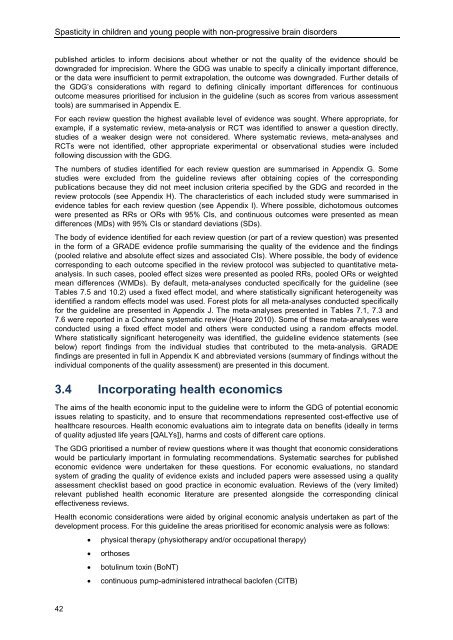National Collaborating Centre for Women's and Children's Health
National Collaborating Centre for Women's and Children's Health
National Collaborating Centre for Women's and Children's Health
You also want an ePaper? Increase the reach of your titles
YUMPU automatically turns print PDFs into web optimized ePapers that Google loves.
Spasticity in children <strong>and</strong> young people with non-progressive brain disorders<br />
published articles to in<strong>for</strong>m decisions about whether or not the quality of the evidence should be<br />
downgraded <strong>for</strong> imprecision. Where the GDG was unable to specify a clinically important difference,<br />
or the data were insufficient to permit extrapolation, the outcome was downgraded. Further details of<br />
the GDG’s considerations with regard to defining clinically important differences <strong>for</strong> continuous<br />
outcome measures prioritised <strong>for</strong> inclusion in the guideline (such as scores from various assessment<br />
tools) are summarised in Appendix E.<br />
For each review question the highest available level of evidence was sought. Where appropriate, <strong>for</strong><br />
example, if a systematic review, meta-analysis or RCT was identified to answer a question directly,<br />
studies of a weaker design were not considered. Where systematic reviews, meta-analyses <strong>and</strong><br />
RCTs were not identified, other appropriate experimental or observational studies were included<br />
following discussion with the GDG.<br />
The numbers of studies identified <strong>for</strong> each review question are summarised in Appendix G. Some<br />
studies were excluded from the guideline reviews after obtaining copies of the corresponding<br />
publications because they did not meet inclusion criteria specified by the GDG <strong>and</strong> recorded in the<br />
review protocols (see Appendix H). The characteristics of each included study were summarised in<br />
evidence tables <strong>for</strong> each review question (see Appendix I). Where possible, dichotomous outcomes<br />
were presented as RRs or ORs with 95% CIs, <strong>and</strong> continuous outcomes were presented as mean<br />
differences (MDs) with 95% CIs or st<strong>and</strong>ard deviations (SDs).<br />
The body of evidence identified <strong>for</strong> each review question (or part of a review question) was presented<br />
in the <strong>for</strong>m of a GRADE evidence profile summarising the quality of the evidence <strong>and</strong> the findings<br />
(pooled relative <strong>and</strong> absolute effect sizes <strong>and</strong> associated CIs). Where possible, the body of evidence<br />
corresponding to each outcome specified in the review protocol was subjected to quantitative metaanalysis.<br />
In such cases, pooled effect sizes were presented as pooled RRs, pooled ORs or weighted<br />
mean differences (WMDs). By default, meta-analyses conducted specifically <strong>for</strong> the guideline (see<br />
Tables 7.5 <strong>and</strong> 10.2) used a fixed effect model, <strong>and</strong> where statistically significant heterogeneity was<br />
identified a r<strong>and</strong>om effects model was used. Forest plots <strong>for</strong> all meta-analyses conducted specifically<br />
<strong>for</strong> the guideline are presented in Appendix J. The meta-analyses presented in Tables 7.1, 7.3 <strong>and</strong><br />
7.6 were reported in a Cochrane systematic review (Hoare 2010). Some of these meta-analyses were<br />
conducted using a fixed effect model <strong>and</strong> others were conducted using a r<strong>and</strong>om effects model.<br />
Where statistically significant heterogeneity was identified, the guideline evidence statements (see<br />
below) report findings from the individual studies that contributed to the meta-analysis. GRADE<br />
findings are presented in full in Appendix K <strong>and</strong> abbreviated versions (summary of findings without the<br />
individual components of the quality assessment) are presented in this document.<br />
3.4 Incorporating health economics<br />
The aims of the health economic input to the guideline were to in<strong>for</strong>m the GDG of potential economic<br />
issues relating to spasticity, <strong>and</strong> to ensure that recommendations represented cost-effective use of<br />
healthcare resources. <strong>Health</strong> economic evaluations aim to integrate data on benefits (ideally in terms<br />
of quality adjusted life years [QALYs]), harms <strong>and</strong> costs of different care options.<br />
The GDG prioritised a number of review questions where it was thought that economic considerations<br />
would be particularly important in <strong>for</strong>mulating recommendations. Systematic searches <strong>for</strong> published<br />
economic evidence were undertaken <strong>for</strong> these questions. For economic evaluations, no st<strong>and</strong>ard<br />
system of grading the quality of evidence exists <strong>and</strong> included papers were assessed using a quality<br />
assessment checklist based on good practice in economic evaluation. Reviews of the (very limited)<br />
relevant published health economic literature are presented alongside the corresponding clinical<br />
effectiveness reviews.<br />
<strong>Health</strong> economic considerations were aided by original economic analysis undertaken as part of the<br />
development process. For this guideline the areas prioritised <strong>for</strong> economic analysis were as follows:<br />
• physical therapy (physiotherapy <strong>and</strong>/or occupational therapy)<br />
• orthoses<br />
• botulinum toxin (BoNT)<br />
• continuous pump-administered intrathecal baclofen (CITB)<br />
42

















